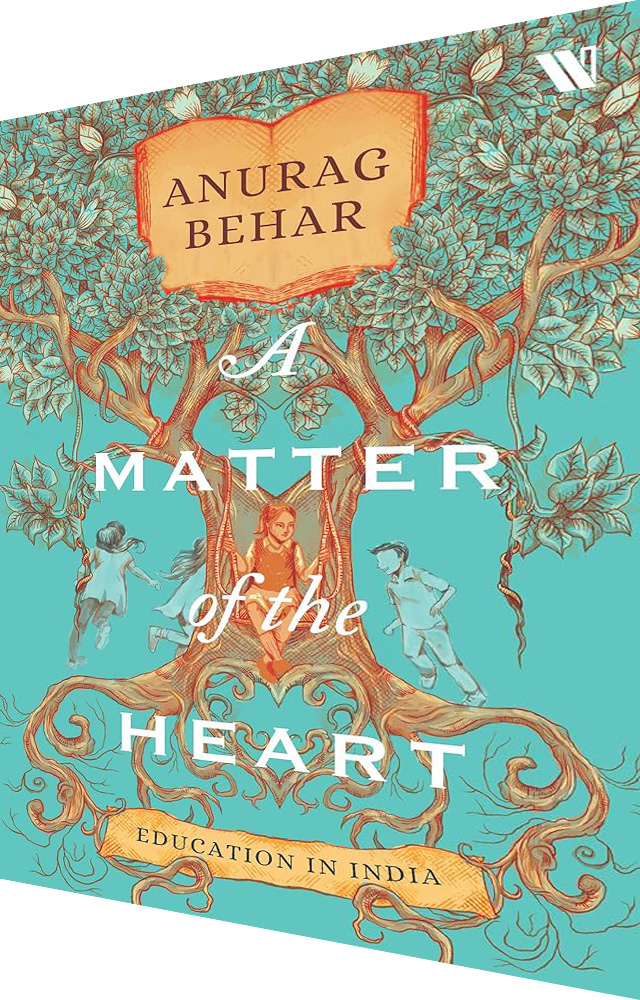 A Matter of the Heart: Education in India
A Matter of the Heart: Education in India
Anurag Behar
westland books
Rs.599
Pages 375
A valuable narrative recounting stories of dedicated teachers transforming the lives of students in nondescript villages and far-flung sites
Anurag Behar has rich experience in the field of education by way of working with the Azim Premji Foundation and travelling extensively at the grassroots level. Like others who have worked in the field, he argues that in the end, good education is ‘A Matter of the Heart’.
This insight is a clear indication of how the profession of teaching is unlike any other. With other caregiving professions, including medicine, accounting, protective forces, and law that require close interaction with the primary stakeholders, patients, clients, etc, a certain level of detachment is warranted, for retaining distance and maintaining professional behaviour. All these rules are a hindrance in the practice of the teachers’ profession. In this vocation, one must be passionate and care deeply and genuinely for students. This is evident in the hundred-odd anecdotes that Behar shares in this volume.
Behar’s extensive fieldwork covers hitherto ignored villages and nondescript sites. The book is a valuable source tapping into stories that would have been lost to history. Documentation of the changes made by the work of Renu Upadhyaya in Uddham Singh Nagar, Uttarakhand; Shobha in Gulbarga, Karnataka, and teachers and principals in different parts of the country, is a reminder for teachers to maintain commitment and zeal towards their work, wherever they are. These are motivational stories of transforming the lives of students and inspiring hope, peace, and possibilities.
Apart from personal commitment and actions of teachers, Behar also highlights the important role of government in education. Through various policies that work against teachers, such as recruiting teachers at various pay levels and inadequate funding, the government has largely relegated public schools to the sidelines. Behar argues that despite the widespread prevalence of private school education, it is government/public schools that can make real impact.
He admits the ability of private players to provide low cost education. But according to him, low fees charging private schools are “parasitic” in their exploitation of the labour market. It is left to the individual teacher who even if dissatisfied with the workplace, to somehow find the inner strength and resolve to provide quality education to students. A committed teacher teaches with her heart not because of good infrastructural facilities, decent pay scale, and a supportive environment, but even despite a lack of all of this. In ‘The Ideology of Education’ (pp. 116-118), he discusses two studies that argue that there’s no substitute for public education in providing quality education at the grassroots.
Two important school practices that can be culled from the anecdotes that Behar shares highlight the importance of community. School-community partnerships, where community members contribute towards improving the quality of education that their children receive, has greatly improved relationships between teachers, administrators and local communities. Community members demonstrate pride in government schools that genuinely work to improve the learning outcomes of children. Building communities of teachers, through teacher volunteer groups, has proven time and again to be effective in improving pedagogic inputs.
This book is divided into six parts. Loosely grouped under themes, every anecdote, in whichever part it may have been placed, can be read independently. But Part VI, the conclusion, is most intriguing. The writing in Part VI brings to the fore the mix of emotions that Behar has experienced in his extensive travels. The writing is a mix of frustration with field realities with the romance of wanting to bring about change. It is titled Is Bahakti hui Duniya ko Sambhalon Yaaron, which although Behar does not translate into English, means ‘manage this delusional, misled world’.
Presented at the end of the innumerable field experiences carefully narrated by the author, it is a cry from the heart, highlighting that enormous commitment and zeal is required to work in the field of education. There are people with exceptional calibre and passion for teaching who are bringing about real change in the lives of children across the country. This is the inspirational message of the book which also draws attention to large scale government apathy towards education.
In the final chapter titled ‘The Importance of being Stubborn’, Behar stresses the importance of zidd — firmness of resolve. It takes tremendous resolve to break barriers of caste, gender, corruption, and resist the pressures of the bourgeoise. “We must all be ziddi together, with a shared moral purpose…” he concludes (p. 372). Although he wrote it in 2016, the condition of education at the grassroots hasn’t changed. We must continue to be ziddi together.























